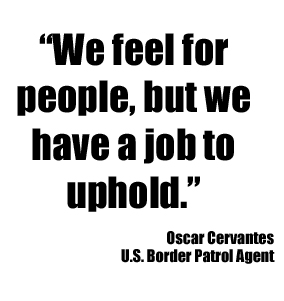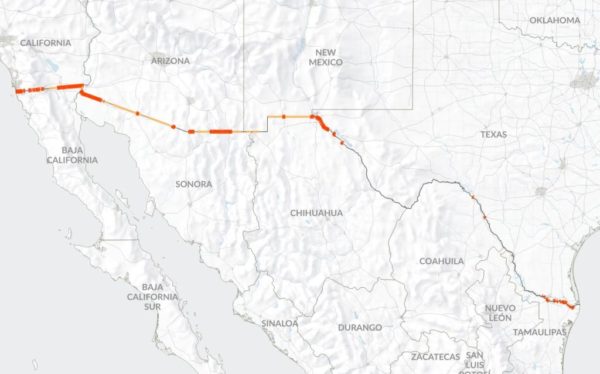by Jennifer Thomas
On paper it sounded like the perfect assignment: spend a day along the U.S. Mexican border with members of the El Paso sector of the U.S. Border Patrol as part of the Dow Jones News Fund Multimedia Journalism Training Academy at UT El Paso. Off we went – cameras, notepads and audio equipment in hand. It was hot. 100 degrees.
Most of us, have in the least read about, if not reported in some way, the border between the two countries, and the migrants who try to cross illegally into the U.S. What we were not prepared for, was to see an apprehension first hand.
 U.S. Border Patrol agent Oscar Cervantes and Joe Reyes served as our guides. Cervantes has been a border agent for more than eight years. Reyes – more than fourteen.
U.S. Border Patrol agent Oscar Cervantes and Joe Reyes served as our guides. Cervantes has been a border agent for more than eight years. Reyes – more than fourteen.
We visited a portion of the 16-foot steel, eight-mile-long fencing that separates Colonia Anapra in Mexico and the village of Sunland Park, New Mexico. The structure has been in place since 2007. “It only takes seconds or minutes to blend into the community,” Cervantes explained.
The El Paso Sector encompasses all of the state of New Mexico and the western tip of Texas, and is one of nine sectors along the Southwest Border of the country. There are 19,000 agents covering more than 250 miles of international border. The section of the border is covered 24 hours a day, seven days a week, but Cervantes insists the fence is not meant anyone out.
“What it’s meant for is to buy time for an agent to respond to an illegal.”

The U.S.-Mexico border fence system today. Pedestrian fence is colored dark orange, vehicle fence in light orange.
Credit:Reveal from the Center for Investigative Reporting
Cervantes says border crossings have been declining. Arrests have decreased approximately 80 percent from last year, from more than 100 arrests per day to 20.
The young women and children who we witnessed in the apprehension, were among them. They were from Guatemala, and asked the agents to let them go. They were among more than 16,000 family unit apprehensions from January of this year, compared to the same time period for Fiscal Year 2016.
Border Patrol agents have the highest suicide rates in all of law enforcement. Cervantes points to the stress of the job. Cervantes, a third-generation Mexican American and a father, admits that seeing children attempt to make illegal entry is difficult.
“People think we’re robots. We’re not,” he said. “We’re humans; do our jobs with compassion… We feel for people but we have a job to uphold.”
This multimedia story was produced for 2017 Dow Jones Multimedia Training Academy by Jon Beaupre, Jennifer Erdely. Brad Mello and Jennifer Thomas.
